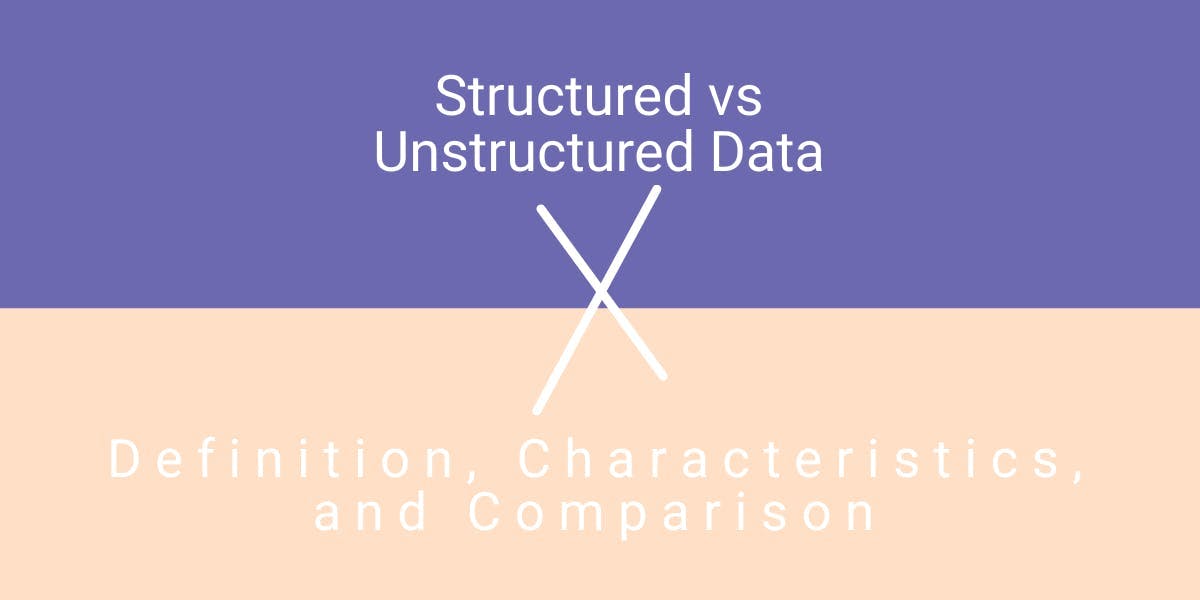Structured vs. Unstructured Data: Definition, Characteristics, and Comparison
Flipnode on May 12 2023

Data can be categorized into two main sections: structured and unstructured data. Structured data is well-organized and easy to analyze, while unstructured data is raw and disorganized, posing challenges for analysis.
In this article, we will delve deeper into the differences between structured and unstructured data and the challenges associated with each. We will highlight the importance of structured data and provide examples of both types. Additionally, we will discuss the definition of semi-structured data format.
So, let's dive right in!
Structured vs unstructured data: main differences
To better understand the differences between structured and unstructured data formats, let's take a quick look at the definitions of each.
What is structured data?
Structured data is characterized by being highly-specific, well-organized, searchable, and concise. It is usually predefined and formatted before being stored, often in a data warehouse. Structured data typically consists of letters or numbers and is arranged in rows and columns of a table, making it easy to organize and analyze.
What is unstructured data?
Unstructured data lacks a predefined format, making it challenging to store and manage in relational databases. This type of data is typically stored in its native format, such as data lakes, and is often text-heavy and voluminous in quantity.
Now, let's break down the main differences:
- Qualitative data vs. quantitative data: Structured data, often referred to as quantitative data, can be expressed in numerical values and answers questions like "How many?" or "How often?" On the other hand, unstructured data, also known as qualitative data, is more characteristic and categorical, often open to interpretation. It helps us understand the "why?" and "how?" behind the structured, numerical data.
- Storage space: Structured data typically requires less storage space, while unstructured data tends to take up more space due to its vast quantity and diverse formats.
- Readability: Unstructured data is harder to read for both humans and bots since it's not stored in relational databases. In contrast, structured data is relatively easy to read, interpret, and analyze.
- Storage types: Structured data is typically stored in relational databases and data warehouses. On the other hand, unstructured data is stored in data lakes, which are storage repositories designed to preserve its raw format for further data analysis.
- Data analysis methods: Structured data is typically analyzed using regular statistical tools or SQL (Structured Query Language). Meanwhile, working with unstructured data requires specific technologies such as machine learning, natural language processing, artificial intelligence, and other advanced tools.
What is semi-structured data?
Before we proceed, it's crucial to understand the definition of semi-structured data.
As the term suggests, semi-structured data is partially structured. Similar to unstructured data, it doesn't conform to relational databases or neatly-organized tables. However, what sets semi-structured data apart is that it contains tags or markers that separate elements and create a hierarchy. Examples of semi-structured data include emails, zipped files, data integrated from multiple sources, and more.
Why is structured data important?
Structured data is formatted to adhere to a specific structure before being stored in data storage. Let's take a closer look at the advantages of structured data:
- Easy for ML algorithms to use: Due to their organized and specific nature, structured data is easily used by machine learning algorithms. ML algorithms can be trained to work with structured data more effectively.
- Business professionals can easily utilize it: Business professionals without extensive technical data knowledge may find it challenging to read, analyze, and understand unstructured data. In contrast, structured data can be easily analyzed even without in-depth data expertise. This enables business professionals to access and utilize the data themselves, without relying heavily on data scientists or similar teams, facilitating proper analysis and business intelligence.
- Wider tool choice: Structured data has been around for longer compared to unstructured data, resulting in the wider availability of tools designed for processing and analyzing structured data. This provides more flexibility in choosing the right tools for data analysis and processing.
- Easy to parse: Since structured data is documented and labeled, it is easy to parse or break it down into separate parts. Extracting the required information from structured data requires minimal effort, as the data is well-organized and labeled.
Examples of structured vs. unstructured data
Examples of structured data:
- Customer information is stored in a relational database, such as names, addresses, phone numbers, and email addresses.
- Sales transaction data is stored in a spreadsheet, with columns for product name, quantity sold, price, and total revenue.
- Inventory data in a database, with fields for product name, SKU, quantity on hand, and location.
Examples of unstructured data:
- Social media posts, which can include text, images, videos, hashtags, and mentions.
- Email messages, which can contain free-form text, attachments, and metadata.
- Audio and video recordings, which may not have a specific structure or format, and can include spoken words, background noises, and visual elements.
- Web pages, which can have varying layouts, styles, and content types, including text, images, videos, and links.
- Sensor data, such as data from IoT devices, which can have different formats, protocols, and structures depending on the device and sensor type.
As evident from real-world examples, the definitions of structured (or quantitative) data and unstructured data align with their characteristics. Structured data is numeric and factual, whereas unstructured data is contextual, hence its qualitative data classification.
Common challenges: structured data
Both structured and unstructured data come with their unique challenges. Starting with structured data, one of the main issues is its lack of flexibility. Due to its reliance on a rigid organizational model, structured data is less adaptable. The column or field configuration is determined by the database schema, and data must fit into its designated column. While this makes processing and searching data easier, it also means that all records must adhere to the strict schema requirements.
Another common issue with structured data is limited storage options. As structured data is typically stored in data warehouses with fixed schemas, any changes in storage settings can result in an automatic refresh of all data in the warehouses. This may require significant time and resources to reconstruct large volumes of data.
Common challenges: unstructured data
When it comes to challenges associated with unstructured data, the main hurdle is the requirement for data science expertise. Working with unstructured data necessitates a deep understanding of the topic or area of the data. A regular business professional may not possess the specialized knowledge of a data scientist that is needed to analyze unstructured information in data lakes.
As mentioned earlier, there are numerous user-friendly tools available for working with structured data, even without a data science background. However, the same cannot be said for unstructured data, as it often requires the use of specific tools, some of which are still in the early stages of development.
Large-scale data acquisition challenges
Whether it’s structured or unstructured data you’re after, you may find it difficult to acquire it in the first place; especially when it comes to automated large-scale data mining operations.
Nowadays, many websites employ several anti-bot measures to prevent malicious actors from harvesting their data. Even if your actions are legal and ethical, these measures may affect you when web scraping. As a result, you may not be able to collect data successfully or even get your IP address banned.
Final thoughts
We hope our comparison of structured and unstructured data has been clear and useful. The key takeaway is that both data types hold great value in different scenarios. Structured data is accessible to a wide range of business professionals, while unstructured data offers greater flexibility in how it can be worked with. Understanding the strengths and limitations of each data type can help businesses make informed decisions about how to best leverage their data assets for their specific needs.



